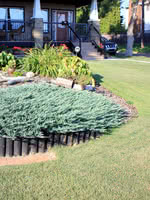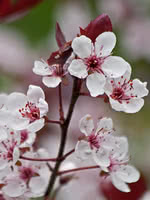Mon-Fri 9am - 5pm Mountain time
Creeping Juniper vs Purple Leaf Sand Cherry
Juniperus horizontalis
Prunus x cistena
NOT AVAILABLE THIS SEASON - MIGHT RETURN
CUSTOM GROW
Creeping Juniper is a low maintenance, spreading, ground cover shrub capable of growing in some of the worst soil and rocky conditions.
You will love this shrubs' pleasant fragrance and year-round color. A beautiful accent or foundation plant, Creeping Juniper has scaly foliage and is commonly used by landscapers to add texture under trees or flower beds. Consider planting Creeping Juniper in areas where grass is difficult to mow or maintain.
Purple Leaf Sand Cherry provides bright reddish-purple leaves that turn bronze-green in the fall. In the spring, tiny flowers with a pinkish white hue bloom. The flowers are small, but the impact comes from the shrub blossoming all at once.
The Purple leaf sand cherry can be susceptible to pests and diseases in more humid areas; a typical life span is approximately 15 years. Not suitable for a privacy hedge on its own but is often alternated with lilacs. Often used as an accent plant that attracts birds and bees.
Creeping Juniper Quick Facts
Purple Leaf Sand Cherry Quick Facts
Toxicity: the leaves and seed are slightly toxic

